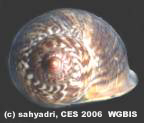A total of 269 species belonging to 24 families and 57 genera have been identified from Western Ghats (Madhyastha et al., 2004). This study is a continuation of the study in Sharavathi Valley region by Mavinkurve et al. (2005). The study assumes significance because; in this study area 11 out of the 24 families of land snails found in the Western Ghats are present.
Sharavathi is one of the major rivers in Mid Western Ghats. It originates at Ambuteertha in Shimoga district (Karnataka) and flows to west to join Arabian Sea at Honnavar. The total length of the Sharavathi is 128 km and it has a catchment area of 2,209 sq. km with 4545 million cu. m annual discharge (Bhat, 2003). The catchment area spreads over 2 districts namely Shimoga and Uttara Kannada. There are two major dams Linganamakki, and Gersoppa constructed across this river.
Study was conducted during the rainy season. Visual search for half an hour in a random transect was employed to collect macro molluscs (>5 mm). The visual search consisted of looking under fallen logs, root buttress, tree bark, and rock crevices. Around ½ kg of leaf litters of the forest floor were collected from different habitats to study the microgastropods. The litter was brought to the laboratory and searched in white-coated trays, with the help of a hand lens for micro molluscs (<5 mm). The live molluscs were first drowned in water for a day, then kept in 10% formaldehyde, for an hour and finally preserved in 70% alcohol. The identifications are mainly based on the Fauna of British India series for m ollusca (Blanford and Godwin-Austen 1908, Gude, 1914, 1921), and on the book ‘Indian land snails' (Mitra et al.2004) and the system of Classification followed is that given in A Classification of Living Mollusca (Vaught, 1989).
SYSTEMATIC ACCOUNT
Class: MOLLUSCA
Sub-class: PROSOBRANCHIA
Order: MESOGASTROPODA
Family: CYCLOPHORIDAE
Sub-family: CYCLOPHORINAE
Genus: Cyclophorus Montfort, 1810 |
|
Cyclophorus altivagus (Benson, 1854)
Distribution : Western Ghats: Karnataka: Karwar, Sharavathi Valley; Maharashtra: Mahableshwar. Measurements: H= 32 mm, W= 36 mm
H= Stands for height W= Stands for width.
Description :
Shell is globose-conic, widely umbilicate, sturdy and opaque. Sutures distinct, apex prominent chestnut coloured, with the periostracum generally corroded. Whorls 5, rapidly increasing, dark brownish, with distinct chestnut flame like streaks from the sutures, and with distinct spiral lirations criss crossed by transverse striations and with visible growth lines. Body whorl with an indistinct keel, a few of the lirations above keel prominent. Aperture rounded, lips double, inner lip slightly protruded, continuous forming a thick callus on the columellar margin. Outer lip expanded and reflected, discontinuous at the point of attachment to the penultimate whorl. |
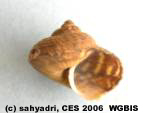 |
Cyclophorus stenomphalus (Pfeiffer, 1846)
Distribution : Western Ghats: Karnataka: Sharavathi Valley; Maharashtra: Mahableshwar. Measurements: H= 20 mm, W= 22 mm.
Description :
Shell is globose-conic, narrowly umbilicate, dark brown in colour with paler streaks, sturdy, and opaque. Sutures distinct and apex acute, prominent, dark brownish coloured with the periostracum generally corroded. Whorls 5½, shouldered, rapidly increasing, with visible growth lines and with distinct spiral lirations interspersed with minute spiral striations. Body whorl with a distinct keel which is darkened, interjected with white patches, 3-5 lirations above the keel prominent, with distinct chestnut flame like streaks, underneath rarely ornated, with radiating striations. Aperture is wide, oblique and rounded, (inside with bluish nacre, when not fully developed). Peristome double, internally reddish, externally expanded, almost thickened, dialated above, angular, columellar margin thickened, slightly reflexed. |
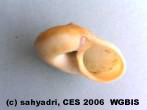 |
Cyclophorus nilagiricus (Benson, 1852)
Distribution : Western Ghats: Karnataka: South Canara, Sullia, Mudigere, Sharavathi Valley; Tamil Nadu: Nilgiris, Travancore, Walaghat, Koondah hills.
Measurements: H= 20 mm, W= 22 mm.
Description:
Shell globose, sturdy, opaque, widely umbilicate, spire short, dark brownish, with distinct chestnut flame like streaks near the sutures, and with distinct spiral lirations criss crossed by transverse striations. Body whorl with an indistinct keel, with 3-5 lirations above the keel prominent, near the suture flattened. Whorls 5, shouldered, rapidly increasing with visible growth lines, sutures distinct. Apex acute, prominent, chestnut coloured with the periostracum generally corroded. Aperture orange coloured, lips thickened and reflected, continuous forming a thick callus on the columellar margin. |
| |
Genus: Cyathopoma Blanford, 1861 |
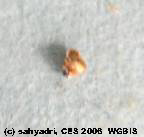 |
Cyathopoma trochlea (Benson, 1851)
Distribution : Western Ghats: Karnataka: Sharavathi Valley; Tamil Nadu: Ooty. Measurements: H= 2 mm, W= 1.5 mm.
Description:
Shell narrowly umbilicate, globose conoid, glabrous, white, apex obtuse, suture impressed; whorls 5, angulately convex, at the top one liration, on the last three carinations are three, one superior, one sub median and one around the umbilicus; aperture oblique, circular; longitudinally equal, peristome acute, at the mouth carinae inferior scarcely angulated, umbilicus deep. This species is marked by the presence of 3 raised carinations, one infra another supra and the final peripheral banding. |
 |
Cyathopoma wynaadense (Blanford, 1868)
Distribution : Western Ghats: Karnataka: Sharavathi Valley; Tamil Nadu: Nilgiris, Ooty; Kerala: Wynaad. Measurements: H= 3 mm, W= 3 mm.
Description:
Shell openly umbilicate, globose conoid, spirally lirated, white, epidermis thin, dark, striated, covering, spire conic, apex almost acute, suture profound, whorls 4½ -5, rounded, close to the suture, last whorl cylindrical, circumference of the umbilicus similar internally with close liration, not compressed, aperture scarcely oblique, circular, not sinuate, peristome double, externally expanded, internally not stretched out. The acute apex and the double peristome, the four elevated lines being present two, above and other two below the periphery differentiate this species. |
| |
Genus: Mychopoma Blanford, 1869 |
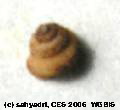 |
Mychopoma seticinctum (Beddome, 1875)
Distribution : Western Ghats: Karnataka: Kodachadri, Sharavathi Valley; Tamil Nadu: Annamalai. Measurements: H= 3 mm, W= 3 mm.
Description :
Shell is globose conoid, furnished with a brownish epidermis, which has a minute vertical striation, very hairy along the periphery otherwise glabrous, white beneath the epidermis. Spire conical, depressed, apex pointed. Whorls 6, descending a little rather suddenly in front, with 12-15 continuous raised spiral costulations, between the suture and the keel. Penultimate with 6-7 costulations, antepenultimate with five or six, and the whole above it with two or three less prominent lines. Peristome double, the inner one pearly white inside and crenated, outer one dialated on its outer and lower margins, somewhat reflexed. Umbilicus exhibiting all the whorls, not surrounded with a hairy fringe outside, spirally ribbed within, and there furnished with a strong raised thread-like sinuate or curved sculpture. |
| |
Genus : Theobaldius G.Nevill, 1878 |
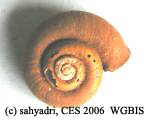 |
Theobaldius tristis (Blanford, 1869)
Distribution : Western Ghats: Karnataka: Kudremukh, Kodachadri, Sharavathi Valley; Goa: Doodhsagar Falls; Tamil Nadu: Tirunelvelli. Measurements: H= 11 mm, W= 17 mm.
Description :
Shell widely umbilicated, slightly elevated, thin, covered with a thick, golden brown epidermis; beneath the epidermis white, faintly striated. Spire convex; suture deep. Whorls 5, rounded, shouldered, the last cylindrical, descending very gradually for a considerable distance behind the aperture. Peristome double, the two portions divided by a groove; the inner slightly projecting, with almost obsolete sinus above, close to the suture; the outer a little expanded and produced above into a short vertical wing, not touching the penultimate whorl. |
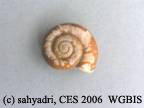 |
Theobaldius ravidus (Benson, 1851)
Distribution : Western Ghats: Tamil Nadu: Annamalai hills, Kalakad-Mundanthurai Tiger Reserve, Nilgiris; Kerala: Wynaad. Elsewhere: Tamil Nadu: Shervoy Hills; Andhra Pradesh: Tirupathi hills. Measurements: H= 8 mm, W= 20mm.
Description :
Shell openly umbilicate, almost discoidal, smooth, olive yellow, below the epidermis almost white, periostracum being very fragile and easily worn off. Spire not elevated, apex flat, obtuse, dark blue in colour, sutures impressed, and canaliculated. Whorls 4, convex, with close rough, thin, radial striations, laterally ascending, last whorl cylindrical, scarcely descending below the penultimate whorl near the mouth. Aperture oblique, circular, peristome thin, straight, margins hard, thin at the point of attachment angular. Umbilicus reveals upto the apex. |
| |
Sub-family: ALYCAEINAE
Genus: Alycaeus Gray, 1850 |
 |
Alycaeus expatriatus (Blanford, 1860)
Distribution : Western Ghats: Karnataka: Kudremukh, South Canara, Sharavathi Valley; Tamil Nadu: Neddoowuttom, Nilgiris, Annamalai. Elsewhere: Tamil Nadu: Shevroy Hills. Measurements: H= 3 mm, W= 4 mm.
Description:
Shell dextral, globose, moderately umbilicate and uniformly pink in colour. Spire short, apex reddish, obtuse; sutures impressed, an accessory canal runs along the suture at the body whorl. Whorls 3½, with thin distinct vertical striations, which are lacking near the aperture, body whorl much inflated, just before the constriction, after which descends considerably towards the aperture forming a vertical keel like swelling. Sutural tube present just before the constriction. Body whorl near the aperture descending and rounded. Lips double, outer expanded, inner lip continuous. Operculum thin, concave, retracts completely up to the constriction. |
| |
Sub-family: PTEROCYCLINAE
Genus: Pterocyclus (Sowerby, 1835)
|
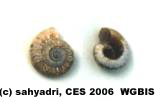 |
Pterocyclus nanus (Benson, 1851)
Distribution : Western Ghats: Karnataka: Mudigere, Kudremukh, Sharavathi Valley; Tamil Nadu: Nilgiris, Annamalai Hills. Elsewhere: Salem. Measurements: H= 11 mm, W= 18 mm.
Description :
Shell discoidal, widely umbilicate, with chestnut coloured undulations above and a darker band at the periphery, white behind the periostracum. Spire depressed, sutures impressed and nearly channelled. Whorls 4½, convex. Aperture is oblique, circular, and peristome double, scarcely discrete. Inner lip is continuous with a sinus near the wing, at the attachment to the penultimate whorl much stretched out, externally reflexed, upper fold narrowly arched, in front concisely descending, angulate in shape, near the base more narrowly reflected. |
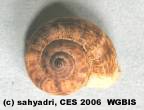 |
Pterocyclus comatus (Mollendorff, 1897)
Distribution : Western Ghats: Karnataka: Sharavathi Valley; Tamil Nadu: Annamalai hills. Measurements: H= 9 mm, W= 15 mm.
Description :
Shell nearly discoid, widely umbilicated, solid, yellowish, regular flame like chestnut streaks present. Spire short, conoid, sutures impressed, almost canaliculated at the junctions and apex obtuse. Whorls 5½ , cylindrical, plicately striated, last whorl near the mouth descending and white near the aperture. Aperture is oblique, circular, and peristome double. The outer lip is with the wing at the point of attachment to the penultimate whorl and much bent, the inner lip is with a deep sinus near the wing and not protruding beyond the expanded outer lip. |
| |
Family: DIPLOMMATINIDAE
Genus: Nicida W. Blanford, 1868
|
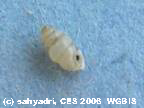 |
Nicida liricincta (Blanford, 1868)
Distribution : Western Ghats: Karnataka: Kudremukh, Sharavathi Valley, Hulikal; Maharashtra: Khandalla. Measurements: H= 3 mm, W= 1.5 mm.
Description :
Shell ovate, imperforate, glossy, thin and translucent. Spire elevated, apex obtuse, sutures impressed. Whorls 5 ½ distinctly sculptured with 2 spiral lirations on third, fourth and 3 on the penultimate whorls, body whorl with 4-5 lirations. The penultimate whorl is the largest, body whorl slightly constricted. Aperture rounded slightly ascending touches nearly half of the penultimate whorl. Lips double, outer lip slightly reflected. |
 |
Nicida nilgirica (Blanford, 1860)
Distribution : Western Ghats: Karnataka: Sharavathi Valley; Tamil Nadu: Pykara, Nilgiris. Measurements: H= 2.5 mm, W= 1 mm.
Description:
Shell dextral imperforate, almost ovate, glossy, thin, smooth, spire conoid, apex obtuse, whorls 6, convex, mildly increasing, last whorl scarcely narrow, mouth ascending. There is a basal keel near the umbilicus. Aperture almost vertical, circular, peristome not dentate, double, external slightly expanded, interrupted, internally moderately stretched, continuous, operculum horny, almost circular, at suture angular, flat, not spiral. |
| |
Genus: Opisthostoma W. & H. Blanford, 1860
|
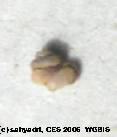 |
Opisthostoma deccanense (Beddome, 1875)
Distribution : Western Ghats: Karnataka: Sharavathi Valley; Tamil Nadu: Kalakad Mundanthurai Tiger Reserve, Sivagiri Hills, Tirunelvelli. Elsewhere: Andhra Pradesh: Nallamalai, Kurnool. Measurements: H= 1.5 mm, W= 0.6 mm.
Description:
Shell irregularly rhomboidal pale pink with an oblique rather distant costulation, prominent on the lowest whorl. Whorls 5, eccentric, the two apical ones very small and depressed, and only visible as single small speck from a side view, the third much larger, convex, the fourth or penultimate, convex, very large, and much dialated, lowest whorl constricted as usual and in front of the constriction deflected inwards, but not concealing the umbilicus; aperture reversed, circular, quite vertical and parallel with the penultimate whorl; peristome touching the centre of the penultimate whorl, double, both lips slightly dialated, with a broad channel between them. |
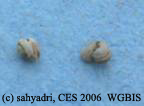 |
Opisthostoma fairbanki (Blanford, 1866)
Distribution : Western Ghats: Karnataka: Kottachadri, Sharavathi Valley; Maharastra: Khandalla. Measurements: H= 1.5 mm, W= 1.5 mm
Description:
Shell cylindrical, narrowly perforate, glossy, thin and translucent. Spire sunken, apex obtuse, sutures impressed. Whorls 5, apical two gradually increasing and sunken, third suddenly increases almost enclosing the former, the penultimate whorl is equal to the third, body whorl constricted and deflected inwards. Whorls sculptured with vertical lirations, which are prominent on the body whorl. Aperture reversed, triangularly rounded, slightly ascending touches nearly half of the penultimate whorl. Lips double, reflected, with a broad channel between them. |
| |
Sub-class: PULMONATA Order: STYLOMMATOPHORA
Family: VERTIGINIDAE
Sub-family: NESOPUPINAE
Genus: Pupisoma Stoliczka, 1873 |
 |
Pupisoma evezardi ( Blanford, 1875)
Distribution : Western Ghats: Karnataka: Nagarholé, Sharavathi Valley. Measurements: H= 2.5 mm, W= 1.5 mm.
Description :
Shell imperforate, with scarcely even a trace of rimation in the umbilical region, conoidly ovate, thin, horny, with raised hair like oblique lines irregularly disposed, on all the whorls. Spire nearly cylindrical below, conoidal above, suture impressed. Whorls 4½, convex; increasing regularly; the last but one larger than the penultimate, rounded at the periphery and below. Aperture diagonal, nearly circular, but truncated above, peristome thin, all in one plane, slightly expanded, margins converging; columellar vertical above, slightly twisted below, reflected and united to the whorl so as completely to cover the umbilicus. |
| |
Family: CERASTUIDAE
Genus: Rachis Albers, 1850
|
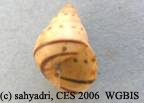 |
Rachis praetermissus (Blanford, 1861)
Distribution : Western Ghats: Karnataka: Dandeli, B. R. Hills, SharavathiValley. Elsewhere: Maharashtra: Bombay; Tamil Nadu: Salem, Madurai; Orissa: Barkuda Island, Chilka Lake; Andhra Pradesh: Nellore.
Measurements: H= 13 mm, W= 21 mm.
Description :
Shell narrowly umbilicate, oblong, conic, thin, striated, yellowish white, with two discontinuous bands and another continuous at the periphery, below which near the umbilicus it is fully chestnut coloured; occasionally white throughout, spire conic, apex acute, generally black. Whorls 7, convex, last whorl more than the spire height. Aperture oblique or nearly ovate, peristome simple, upright, columellar margin vertical, arches reflexed. The tumid body whorl and the very delicate shell distinguish this species. The upper two bands are discontinuous and present on the penultimate whorl also. |
| |
Family: STREPTAXIDAE Sub-family: STREPTAXINAE
Genus: Streptaxis Gray, 1837 |
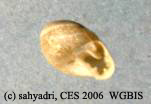 |
Streptaxis scalptus (Blanford, 1899)
Distribution: Western Ghata: Karnataka: B. R. Hills, Bhagmandala, Thalakaveri, Sharavathi Valley; Tamil Nadu: Kalakad-Mundanthurai Tiger Reserve. Measurements: H= 7 mm, W= 12 mm.
Description :
Shell moderately umbilicate, and white in colour, thick and sturdy. Spire flattened. Whorls 5½ nearly flat, rapidly increasing, sutures impressed, surface with transverse striations. Penultimate whorl rounded projecting scarcely beyond the ultimate whorl, which is exccentric and flattened below. Aperture axe shaped, with indentations present behind the peristome, which is reflected, lips thin. Aperture with bifid re entering parietal lamella and 6 palatal teeth, two basal, two columellar and two on the right margin. Umbilicus shallow. This species is endemic to Karnataka. It is distinguished from the by the presence of an extra columellar tooth, basal tooth being slightly left to the lamella and a deeper umbilicus. |
| |
Streptaxis canaricus (Blanford, 1869)
Distribution: Karnataka: South Canara, Sharavathi Valley (Markuttuka).
Measurements: Shell damaged
Description :
Shell dextral, moderately umbilicate, and white in colour, thick and sturdy. Spire short, apex obtuse. Whorls 5½ nearly flat, rapidly increasing, sutures impressed, surface with transverse lirations. Penultimate whorl sharply keeled projecting more than the body whorl, which is slightly diverging from the columellar axis and flattened below. Aperture axe shaped, with indentations present behind the peristome, which is reflected, lips thin. Aperture with a deeply re entering parietal lamella and 6 palatal teeth, two basal, two columellar and two on the right margin. Umbilicus shallow. |
| |
Family: ENDODONTIDAE Genus: Philalanka Godwin-Austen, 1898 |
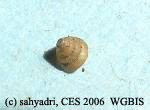 |
Philalanka daghoba (Blanford, 1861)
Distribution : Western Ghats: Karnataka: Sharavathi Valley; Tamil Nadu: Patachamalai, Kalreyanmalai. Measurements: H= 3 mm, W= 3.5 mm.
Description :
Shell narrowly perforated, depressed, pyramidal, with slightly twisted oblique striations, carinate, sutures impressed, whorls 7-8, laterally ascending, almost convex, last whorl not descending, much carinated, internally convex, smooth, at the umbilicus impressed, aperture almost straight, depressed, axe shaped, peristome acute at the umbilicus reflexed internally, two minute dentations in the front are present. This species differentiated by the presence of the prominent keel and the pair of minute denticles |
| |
Family: SUCCINEIDAE
Sub-family: SUCCINEINAE
Genus: Succinea Draparnaud, 1801 |
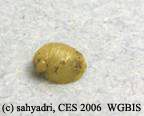 |
Succinea raoi (Subba Rao & Mitra, 1976)
Distribution : Western Ghats: Karnataka: Sharavathi Valley (Kathalekan); Maharashtra: Khandalla, Pune. Measurements: H= 3 mm, W= 2.5 mm.
Description:
Shell dextral, imperforate, glossy upon cleaning the black deposition on the surface, hay coloured, thin and delicate. Spire short, apex obtuse. Whorls 3, rounded, rapidly increasing, sutures shallow, surface with transverse striations converging with the lines of growth and decussated by faint spiral striations. The body whorl is disproportionately large. Aperture more than double the spire, lips thin, columella chestnut coloured. |
| |
Family: HELICARIONIDAE
Sub-family: SESARINAE
Genus: Kaliella Blanford, 1883
|
 |
Kaliella barrackporensis (Pfeiffer, 1852)
Distribution : Western Ghats: Karnataka: Shravathi Valley; Maharashtra: Khandalla. Elsewhere: Widely distributed from Kashmir to Kanya Kumari; Burma, Sri Lanka, Madagascar. Measurements: H= 3 mm, W= 2.5 mm.
Description :
Shell subperforate, pyramidal, thin, obliquely striated or rather microscopically costulately ribbed above, concentrically and fairly closely marked with impressed lines, on the base smooth, translucent, horny brown; spire conical, sides very slightly convex, suture impressed; whorls 6, convex, slowly increasing, the last keeled, not descending, slightly convex beneath; aperture oblique, subquadrately lunate; peristome simple, thin, straight; columellar margin slightly oblique, reflected concealing perforation. |
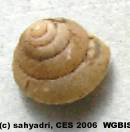 |
Kaliella sigurensis (Godwin- Austen, 1882)
Distribution : Western Ghats: Karnataka: Sharavathi Valley; Tamil Nadu: Nilgiris, Neddoowuttom. Measurements: H= 3.5 mm, W= 3.5 mm.
Description :
Shell subperforate, pyramidally trochiform, thin, obliquely striated, having distinctly oblique radiating striae on the base, smooth, translucent, horny brown; spire conical, sides very slightly convex, suture impressed, whorls 6, convex, slowly increasing, the last keeled, not descending, slightly convex beneath; aperture oblique, subquadrately lunate; peristome simple, thin, straight, columellar margin slightly oblique, reflected, concealing the perforation. This species is marked by the presence of the radiating striations on the shell. |
| |
Family: ARIOPHANTIDAE Sub-family: ARIOPHANTINAE
Genus: Ariophanta Desmoulins, 1829 |
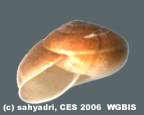 |
Ariophanta immerita (Blanford, 1870)
Distribution : Western Ghats: Karnataka: South Canara, Karwar, Sharavathi Valley. Measurements: H= 32 mm, W= 38 mm
Description :
Shell sinistral, moderately umbilicate, thin, fragile, and translucent. Apex obtuse, dark brown above with a whitish band at the periphery after which the colour fades into white nearing the umbilicus, whorls rapidly increasing, and sutures not impressed. Whorls 5, surface with smooth transverse striations on body whorl distinctly angled, rounded near the aperture in mature forms; it takes the appearance of a keel in younger forms. Body whorl near the aperture scarcely descending, with nacre just behind the slight pinkish aperture, lips slightly thickened. Upper lip flattened, basal lip inflated and rounded, columellar lip triangularly reflected, but does not cover the comparatively wider umbilicus. |
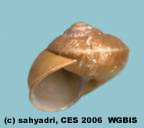 |
Ariophanta canarica (Blanford, 1901)
Distribution : Western Ghats: Karnataka: Madikeri, South Canara, Karwar, Sharavathi Valley. Measurements: H= 30 mm, W= 32 mm
Description :
Shell sinistral, globosely turbinate, rather solid, openly perforate, brownish horny, closely and rugosely striated, the striae decussated above by fine sub obsolete impressed lines, rapidly increasing, whorls 5, almost flat above, the last keeled at the periphery, descending beneath the keel towards the mouth, swollen beneath, somewhat compressed around the perforation; spire conoid, apex subacute; sutures slightly impressed, aperture diagonal, rounded; peristome in one plane, slightly thickened and a little expanded in adults, columellar margin broadly reflexed. |
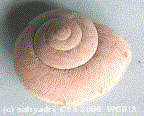 |
Ariophanta interrupta (Benson, 1834)
Distribution : Western Ghats: Karnataka: Sharavathi Valley. Elsewhere: Andhra Pradesh, Jharkhand, Orissa, West Bengal, Bangladesh.
Measurements: H= 28 mm, W= 39 mm.
Description :
Shell large, rather depressedly globose, sinistral, thin, brownish slightly darker below the periphery and becoming lighter on the base, marked by raised oblique lines above, whorls 4-5 last sub angulate at the periphery rounded below. Peristome thin, columella reflected at the perforation. |
| |
Genus: Cryptozona Moerch, 1872
|
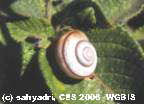 |
Cryptozona solata (Benson, 1848)
Distribution: Western Ghats: Karnataka: Kodachadri, Kudremukh, Sharavathi Valley, Coorg; Tamil Nadu: Nilgiris. Measurements: H= 16 mm, W= 26 mm
Description :
Shell subglobosely depressed, moderately umbilicate and translucent. Spire moderate, apex obtuse, pinkish turning white as the shell grows. Shell with small specks all over the body whorl; with a chestnut coloured band at the periphery, coinciding with the sutures and another just below it visible only on the body whorl, both the bands end abruptly just behind the aperture and with numerous small, brownish, translucent spots irregularly distributed. Whorls 5½, flatly convex above, sutures impressed, surface with smooth transverse striations. Aperture negligibly descending, lips thin, white but just behind, it is hay coloured, inside it has nacre. Upper lip flattened, basal lip inflated and rounded, columellar lip triangularly reflected, partly covering the umbilicus.
|
| |
Genus: Euplecta Semper, 1870 |
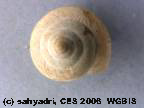 |
Euplecta cacuminifera (Benson, 1850)
Distribution : Western Ghats: Karnataka: Sharavathi Valley; Tamil Nadu: Nilgiris, Sispara. Measurements: H= 12 mm, W= 20 mm
Description :
Shell obtectly perforate, trochiform, thin, horny. Spire conoidal with concave, sides, apex attenuate and sutures channelled and impressed. Whorls 8, slowly increasing, flat above, with fine granular sculpture above, arranged on the oblique striae of growth in spiral longitudinal series, varying slightly and somewhat irregularly in size, some series or parts of series of granules being larger than others; the last acutely keeled, compressed below the keel, aperture scarcely oblique, sharply angulate at the periphery; peristome thin, columellar margin oblique, triangularly reflected above, partly covering the perforation. |
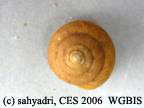 |
Euplecta indica (Pfeiffer, 1846)
Distribution : Western Ghats: Karnataka: Madikeri, South Canara, Mudigere, Kadur, Sharavathi Valley; Tamil Nadu: Annamalai, Nilgiris, Palani Hills; Kerala: Travancore, Chittor. Elsewhere: Andhra Pradesh, Sri Lanka and Maldives. Measurements: H= 9 mm, W= 22 mm
Description :
Shell subturbinate, lenticular, rather solid, perforate, isabelline to fulvous throughout, ornamented above with slightly arcuate costulation, decussated by impressed spiral lines, which are often obsolete, each rib bearing raised points or granules at subequal distances; whorls 5½ - 6, slowly increasing, convex, the last keeled, smooth beneath and radiately striated below the keel, lower surface moderately swollen; spire conoid, with convex sides, aperture oblique, angularly lunate; peristome white, columellar margin oblique, curved, briefly reflexed above. |
| |
Sub-family: MACROCHLAMYDINAE
Genus: Macrochlamys Benson, 1832
|
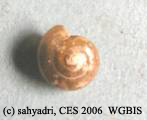 |
Macrochlamys woodiana ( Pfeiffer, 1851)
Distribution: Western Ghats: Karnataka: Shravathi Valley; Tamil Nadu: Kolamalai Hills, Tirchurapalli, Arcot, Myhendra, Travancore. Elsewhere: Sri Lanka. Measurements: H= 5.5 mm, W= 12 mm
Description :
Shell very narrowly umbilicated, depressed, thin, smooth, glassy, and yellowish to fulvous horny. Spire low, conoidal, apex rather prominent, suture well impressed. Whorls 6, convex, increasing slowly, the last scarcely broader, bluntly subangulate at periphery. Aperture oblique, broadly lunate, peristome thin, basal margin slightly arcuate, columellar curved, oblique not reflected over the umbilicus, but carried forward for a short distance. |
| |
Macrochlamys prava (Blanford, 1904)
Distribution: Western Ghats: Karnataka: Sharavathi Valley; Tamil Nadu: Nilgiri Hills, Annamalai Hills; Kerala: Travancore. Elsewhere: Beypur.
Measurements: H= 5 mm, W= 10 mm
Description :
Shell depressed thin smooth polished with traces of close sub obsolete, irregular longitudinal striation visible under a microscope. Spire low conoidal, suture faintly impressed. Whorls five convex and the last considerably broader. Well rounded at the periphery and other tumid below, aperture almost vertical, sub ovately lunate almost circular. Peristome thin, straight columellar margins almost vertical, sub ovately thin, straight, columellar margin almost vertical and slightly reflected above, curved below. |
| |
Genus : Mariaella Gray, 1855
|
 |
Mariaella dussumieri (Gray, 1855)
Distribution: Western Ghats: Maharashtra: Mahableshwar, Poona; Karnataka: Kodagu, Karwar, Kudremukh, Sharavathi Valley; Kerala: Wynaad. Elsewhere: Sri Lanka. Measurements: At full stretch 46 mm.
Description :
Asign, with internal shell, flat, solid in mature forms, with beak like apex, sides sharp, hay yellow in colour, spire indistinct. Yellowish with dark brown spots present in the hind region in older forms, the spots are not distinct in the younger. Shell is internal, partly visible, externally through the pore present on the top of the mantle. Mantle lobes united to form a shield enclosing the various systems, on the surface with two ridges running almost parallel to each other, the right one from the respiratory orifice to the shell aperture the other round the left margin. Posterior portion sharply keeled behind the mantle, ending in the mucus pore. Foot tripartite, edges with short vertical black parallel lines. |
| |
Sub-family: DURGELLINAE
Genus: Sitala Adams, 1885 |
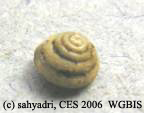 |
Sitala palmaria (Benson, 1864)
Distribution : Western Ghats: Karnataka: Kudremukh, Nandidurga, Sharavathi Valley; Kerala: Wynaad. Measurements: H=0.5 mm, W= 1.5 mm
Description :
Shell perforate, subturbinate, marked with spiral ridges, 5 or 6 on the lowest whorl, 4 on the next higher, and with fine oblique regular lines above, smooth with radiating striae beneath, whitish horny; spire conoid, with convex sides, apex obtuse, smooth, suture impressed; whorls 5 ½ , convex, the last carinate, moderately convex beneath; aperture oblique. Angularly lunate; peristome thin, straight, columellar margin broadly expanded above. |
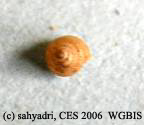 |
Sitala denselirata (Preston, 1908)
Distribution: Western Ghats: Karnataka: Sharavathi Valley; Maharashtra. Elsewhere: Andaman Islands. Measurements: H=3 mm, W= 2 mm
Description :
Shell small conical, subtrochiform, perforate, fairly thick, pale yellowish, sculptured by distinctly raised subdistant spiral markings, about 5-6 on each whorl, spiral markings are more distinct on upper whorls. Spire conical apex obtuse. Whorls 6½, slightly convex, the last bluntly keeled at the periphery, fairly convex beneath. Aperture subvertical, sub quadrate; peristome thin. Columnar margin vertical reflected over the perforation. |
| |
Family: CAMAENIDAE
Sub-family: CAMAENINAE Genus: Chloritis Beck, 1837 |
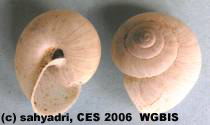 |
Chloritis propinqua (Pfeiffer, 1857)
Distribution : Western Ghats: Karnataka: Dandeli Sharavathi Valley; Maharastra: Satara, Broach, Khandala, Poona, Mahableshwar; Kerala: Palani Hills. Elsewhere: Mumbai, Karnataka: Belgaum Measurements: H=13 mm, W= 18 mm.
Description:
Shell moderately umbilicated, depressed conoid, Whitish with reddish brown supra peripheral band. Whorls 4½, increasing slowly, last widening suddenly towards the mouth, slightly constricted above behind the peristome. Peristome white thickened and reflexed, upper outer and basal margins regularly curved, ascending columellar margin triangularly reflected. Protoconch microscopically granulated, the later whorls densely crowded with minute hair-scars arranged in quincunx and usually disappearing in weathered specimens on the last whorls, which is slightly and sparsely wrinkled in places below.
|
DISCUSSION:
The collected specimens belong to 11 families and 24 genera. Tthese 35 species are identified up to species level (systematic account with photograph given) and the other 9 to generic level. Ariophantidae is the most diverse family with 7 genera and 11 species whereas Succineidae, Vertiginidae, Endodontidae, Helicarionidae, Streptaxidae, Camaenidae, Cerastuidae are represented by only one genus and most with only one species. Out of 35 species identified 43% species are microgastropods, 19 are macro gastropods and one is a slug. 21 species of these snails are endemic to Western Ghats.
Ariophanta interrupta , Sitala denselirata are new addition to the Western Ghats. Cyathopoma trochlea, Cyclophorus stenomphalus, Pterocyclus comatus, Nicida nilagerica, Philalanka daghoba, Kaliella sigurensis, Euplecta cacuminifera are new addition to the checklist of Karnataka (Mavinkurve et al, 2004). Nicida liricincta, Cyclophorus altivagus, Cyclophorus stenomphalus, Ariophanta immerita were more common. Pupisoma evezardi, Cyclophorus nilagiricus , Succinea raoi are less abundant species.
Recent evidence shows that the invertebrates can be more reliable indicators of “hotspots” of high diversity and overall endemism (Moritz et al., 2001). Land snails are very good indicators of land use changes (Aravind et al., 2005), and are among the most severely threatened animals (Seddon 2000). Nearly 65% of all the extinctions of modern times are from molluscs (IUCN). More data on endemism, rarity, and distribution needed to formulate the conservation strategies so as to put break on the speed of extinction.
REFERENCES:
- Aravind, N.A., Rajashekhar, K. P. and Madhyastha, N.A. (2005). Species diversity, endemism and distribution of the land snails of the Western Ghats, India. Records of the Western Australian Museum Supplement 68: 31-38.
- Bhat, A. (2003). Diversity and composition of fresh water fishes in river systems of Central Western Ghats, India . Environmental Biology of Fishes 68 : 25-38.
- Blanford, W. T. and Godwin-Austin, H. H. (1908). Fauna of British India. Mollusca Vol.I Testacellidae and Zonitidae. Taylor and Francis, London.
- Gude, G. K. (1914) . Fauna of British India. Mollusca Vol. II Trochormaphidae Janellidae. Taylor and Francis, London.
- Gude, G. K. (1921). Fauna of British India. Mollusca Vol. III, Land Operculates . Taylor and Francis, London.
- IUCN RED DATA BOOK 2004
- Madhyastha,N. A., Mavinkuruve, R. G. and Shanbhag, S .P. (2004). Land snails of Western Ghats . In A. K. Gupta, A. Kumar and V. Ramakantha (eds), ENVIS Bulletin : Wildlife and Protected Areas, Conservation of rain forest in India 4 :143-151.
- Mavinkuruve, R. G., Sandhya P. S and Madhyastha, N. A. (2005). The land snails of Sharavathi Wildlife Sanctuary. Rec. Zool. Surv. India 104 (part 1-2) : 123-131.
- Mavinkuruve, R.G., S.P. Shanbhag and Madhyastha, N. A. (2004). Checklist of terrestrial gastropods of Karnataka, India. Zoos' Print Journal 19 :1684-1686.
- Mitra, S. C., Dey, A. and Ramakrishna (2004) . Pictorial Handbook – Indian Land snails (Selected Species). Director, Zool. Surv. India, Kolkatta.
- Moritz, C., Richardson, K. S., Ferrier, S., Monteith, G. B., Stanisic, J., William, S.E. and Whiffin, T. (2001) . Bio geographical concordance and efficiency of taxon indicators for establishing conservation priority in a tropical rain forest biota. Proceedings of the Royal Society of London, B 268 : 1875-1881.
- Vaught, K. C. (1989). A Classification of the living Mollusca. (Eds. R. T. Abbott and K. J. Boss). American Malacologists, Melbourne, Florida 32902, USA.
- www.iucnredlist.org (2004)
ACKNOWLEDGEMENTS:
The authors are grateful to the Ministry of Environment and Forests, Government of India, for a project under the AICOPTAX scheme. They also thank the Principal, Poornaprajna College, Udupi, for support. The research scholars of CES (IISc), Bangalore helped us during collection.
